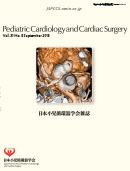Volume 31, Issue 5
Displaying 1-12 of 12 articles from this issue
- |<
- <
- 1
- >
- >|
Editorial
-
Subject area: Editorial
2015Volume 31Issue 5 Pages 227-228
Published: 2015
Released on J-STAGE: December 04, 2015
Download PDF (130K)
Originals
-
Subject area: Original
2015Volume 31Issue 5 Pages 229-237
Published: September 01, 2015
Released on J-STAGE: December 04, 2015
Download PDF (6936K) -
Subject area: Original
2015Volume 31Issue 5 Pages 240-245
Published: September 01, 2015
Released on J-STAGE: December 04, 2015
Download PDF (385K) -
Subject area: Original
2015Volume 31Issue 5 Pages 246-253
Published: September 01, 2015
Released on J-STAGE: December 04, 2015
Download PDF (1150K) -
Subject area: Original
2015Volume 31Issue 5 Pages 254-264
Published: September 01, 2015
Released on J-STAGE: December 04, 2015
Download PDF (1222K)
Case Reports
-
Subject area: Case Report
2015Volume 31Issue 5 Pages 271-277
Published: September 01, 2015
Released on J-STAGE: December 04, 2015
Download PDF (6154K) -
Subject area: Case Report
2015Volume 31Issue 5 Pages 278-281
Published: September 01, 2015
Released on J-STAGE: December 04, 2015
Download PDF (5528K) -
Subject area: Case Report
2015Volume 31Issue 5 Pages 284-287
Published: September 01, 2015
Released on J-STAGE: December 04, 2015
Download PDF (1796K)
Editorial Comments
-
Subject area: Editorial Comment
2015Volume 31Issue 5 Pages 238-239
Published: September 01, 2015
Released on J-STAGE: December 04, 2015
Download PDF (142K) -
Subject area: Editorial Comment
2015Volume 31Issue 5 Pages 265-267
Published: September 01, 2015
Released on J-STAGE: December 04, 2015
Download PDF (201K) -
Subject area: Editorial Comment
2015Volume 31Issue 5 Pages 268-270
Published: September 01, 2015
Released on J-STAGE: December 04, 2015
Download PDF (162K) -
Subject area: Editorial Comment
2015Volume 31Issue 5 Pages 282-283
Published: September 01, 2015
Released on J-STAGE: December 04, 2015
Download PDF (135K)
- |<
- <
- 1
- >
- >|
